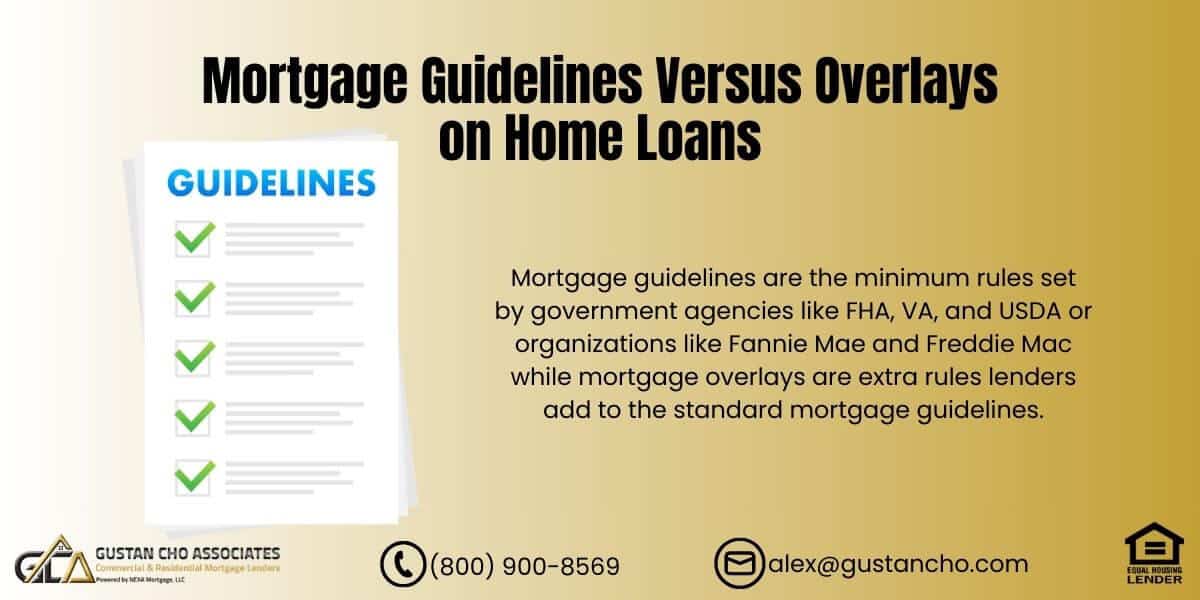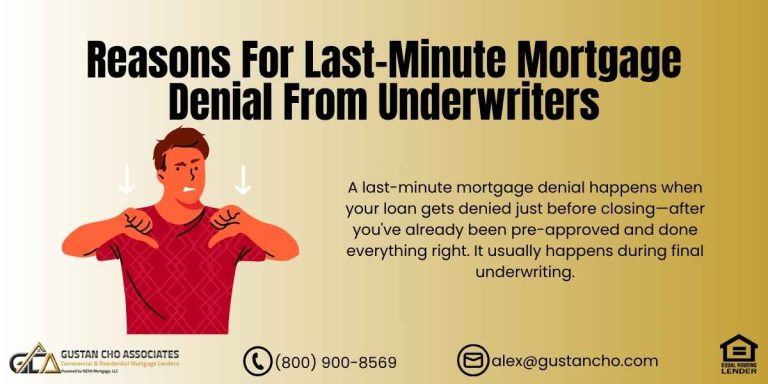Mortgage Guidelines Versus Overlays: What You Need to Know in 2024
When you’re ready to buy or refinance a home, it can be frustrating to find out that despite meeting all the mortgage requirements, your lender still denies you. You might wonder, “Why don’t I qualify if I meet all the guidelines?” The answer often lies in something called mortgage overlays. In this guide, we’ll break down mortgage guidelines versus overlays in simple terms so you can feel confident about getting approved for your home loan.
By the end of this post, you’ll know what mortgage guidelines are, what overlays are, and how they can impact your ability to get a mortgage—even if you technically meet all the requirements set by agencies like FHA, VA, USDA, Fannie Mae, and Freddie Mac.
What Are Mortgage Guidelines?
Let’s start with the basics: Mortgage guidelines are the minimum standards set by government agencies or organizations like FHA, VA, USDA, Fannie Mae, and Freddie Mac. These guidelines cover things like:
- Minimum credit score requirements
- Debt-to-income (DTI) ratios
- How lenders should handle things like collections and charge-offs
- Employment and income verification
These guidelines are the rules of the road that lenders must follow when deciding if a borrower qualifies for a home loan. If you meet the agency guidelines, you should be eligible for a loan—right?
Well, not always. That’s where mortgage overlays come into play.
What Are Mortgage Overlays?
Mortgage overlays are additional rules or restrictions lenders impose on top of the standard agency guidelines. Think of them as a second layer of requirements that go above and beyond what FHA, VA, USDA, Fannie Mae, or Freddie Mac say is necessary.
For instance, although the FHA might require a 580 minimum credit score to be eligible for a home loan with a 3.5% down payment, your lender could stipulate that they will not consider any borrower with a credit score lower than 640. This additional requirement is known as a mortgage overlay.
Confused About Mortgage Guidelines vs. Overlays? Let’s Clear It Up!
Contact us today to understand the difference and how overlays might affect your loan application.
Why Do Lenders Have Overlays?
Lenders use overlays to reduce their risk. Even though a borrower may technically qualify under agency guidelines, the lender may feel that additional safeguards are necessary to protect themselves from borrowers defaulting on loans. These overlays are basically their way of ensuring they feel comfortable lending you money.
Some common reasons lenders add overlays include:
- Lowering the risk of loan defaults
- Managing their portfolio of loans more carefully
- Ensuring loans meet their in-house underwriting standards
How Do Mortgage Overlays Impact Borrowers?
Here’s where things get tricky: you could meet all the FHA, VA, or USDA guidelines and still be denied for a loan because your lender has overlays. This is why it’s so important to understand the difference between mortgage guidelines versus overlays.
For example:
- Credit score overlay: According to FHA guidelines, the minimum credit score needed for a 3.5% down payment is 580, but your lender might require a 640 score.
- Debt-to-income ratio (DTI) overlay: FHA allows a maximum DTI ratio of 56.9%, but your lender might cap it at 45%.
- Overlays on collections: FHA doesn’t require you to pay off old collections, but your lender might.
Overlays are why many homebuyers get confused when told they don’t qualify for a mortgage. It’s not that you don’t meet the guidelines—it’s that you don’t meet that particular lender’s overlays.
Common Mortgage Overlays You Should Know About
Let’s look at some of the most common overlays that can affect your ability to get approved for a mortgage in 2024.
1. Credit Score Overlays
As mentioned earlier, a credit score overlay is when a lender requires a higher credit score than the agency guideline. For example, FHA allows a 580 credit score, but many lenders require 620 or even 640.
2. Debt-to-Income Ratio (DTI) Overlays
The debt-to-income ratio compares the amount of money you pay toward debts each month to your monthly income. FHA guidelines allow a DTI ratio of up to 56.9%, but some lenders may have overlays requiring it to be lower—often around 43% to 45%.
3. Overlays on Collections and Charge-Offs
HUD doesn’t require you to pay off collections or charge-off accounts to qualify for an FHA loan. However, many lenders add an overlay that insists these accounts are paid off before you can get approved. This can be a real issue because paying off old collections can lower your credit score.
4. Overlays on Employment History
FHA requires that borrowers have at least two years of stable employment. Some lenders, however, may add overlays requiring longer work history or even certain types of employment verification that go beyond FHA guidelines.
5. Reserves and Gift Funds
HUD allows borrowers to use gift funds for a down payment. Some lenders, however, might add overlays that limit how much gift money can be used or require that you have a certain amount of your own money (known as reserves) in the bank after closing.
Can You Avoid Mortgage Overlays?
Yes, you can avoid overlays! Some lenders, known as no overlay lenders, only impose additional requirements within the standard agency guidelines. These lenders will approve your loan if you meet the minimum standards set by FHA, VA, USDA, Fannie Mae, or Freddie Mac.
What Is a No Overlay Lender?
A no overlay lender is exactly what it sounds like—one that follows only the minimum guidelines set by FHA, VA, USDA, or Fannie Mae and doesn’t add any extra requirements. These lenders can be a lifesaver if you’ve been denied by other banks or lenders that impose overlays.
For example, if your credit score is 580 and you meet all the FHA requirements, a no overlay lender like Gustan Cho Associates can approve you even if other lenders have turned you down.
Mortgage Guidelines Versus Overlays: A 2024 Update
In 2024, many lenders are tightening their overlays, especially in light of ongoing economic uncertainty. Lenders are becoming more cautious, meaning you might run into more overlays than in previous years. This can make it harder for borrowers with less-than-perfect credit or higher debt-to-income ratios to qualify for a home loan.
However, it’s important to know that no overlay lenders will approve loans based solely on agency guidelines. If one lender has turned you down, don’t give up—your next step should be to find a lender without overlays.
FHA Loans and Overlays in 2024
FHA loans remain a favored choice among homebuyers, particularly individuals with lower credit scores or higher debt-to-income ratios. However, not all lenders offer FHA loans without overlays.
For instance, according to FHA regulations, individuals with 580 credit scores and a 3.5% down payment can be eligible. However, many lenders will impose a credit score overlay, requiring a minimum of 620 or 640. The same applies to debt-to-income ratios and other factors like collections and charge-offs.
Mortgage Guidelines vs. Overlays—What’s the Difference? Let’s Make It Simple!
Contact us today to get a clearer picture and see how it applies to your mortgage.
How to Get Pre-Approved Without Lender Overlays
If you’ve been denied an FHA loan or other government-backed loan because of overlays. No overlay lenders like Gustan Cho Associates can help you get approved based on the minimum agency guidelines. Here’s how to get started:
- Gather Your Documents: Gather all necessary documentation, including proof of income, bank statements, and credit reports.
- Find a No Overlay Lender: Look for lenders who don’t add extra overlays to their loans. These lenders will approve you based on agency guidelines alone.
- Apply for Pre-Approval: Submit your application to a no overlay lender to get pre-approved for your home loan. Before applying, ensure you meet all the FHA, VA, or USDA guidelines.
Overlays on Chapter 13 Bankruptcy
One of the most common overlays is the waiting period after Chapter 13 bankruptcy. FHA guidelines allow borrowers to qualify for a home loan one year after filing for Chapter 13 bankruptcy if they have made 12 on-time payments and have Trustee approval. However, many lenders add an overlay requiring a one or two-year waiting period after the bankruptcy is discharged.
This can frustrate borrowers who meet all the FHA guidelines but are still denied because of lender overlays. In this case, a no overlay lender can help.
Final Thoughts: How to Navigate Mortgage Guidelines Versus Overlays
The most important thing to remember when looking at mortgage guidelines versus overlays is that every lender is different. Just because one lender turns you down doesn’t mean you won’t qualify with another. If you meet the basic agency guidelines, you may be able to get approved with a lender that doesn’t impose overlays.
Don’t lose hope if you’ve been told you don’t qualify for a mortgage. A no-overlay lender can help you get approved for the home loan you deserve.
Ready to take the next step? Contact Gustan Cho Associates today at 800-900-8569 or email gcho@gustancho.com to find out how we can help you get pre-approved without overlays. We’re available 7 days a week to guide you through the home loan process.
Frequently Asked Questions About Mortgage Guidelines Versus Overlays:
Q: What are Mortgage Guidelines?
A: Mortgage guidelines are the minimum rules set by government agencies like FHA, VA, and USDA or organizations like Fannie Mae and Freddie Mac. These guidelines outline the basic requirements for qualifying for a home loan, such as minimum credit scores and debt-to-income (DTI) ratios.
Q: What are Mortgage Overlays?
A: Mortgage overlays are extra rules lenders add to the standard mortgage guidelines. For example, while FHA may allow a 580 credit score, your lender might require a 640 score. These extra requirements make it harder for some borrowers to qualify.
Q: Why do Lenders Use Overlays?
A: Lenders use overlays to protect themselves from risk. Even if a borrower meets the minimum mortgage guidelines, a lender may add overlays to reduce the chances of loan defaults, ensuring they feel comfortable lending money.
Q: What’s the Difference Between Mortgage Guidelines Versus Overlays?
A: Mortgage guidelines are the basic rules agencies like FHA, VA, and USDA set. At the same time, overlays are additional requirements set by individual lenders. A borrower can meet the mortgage guidelines but still be denied a loan if the lender has stricter overlays.
Q: Can I Avoid Mortgage Overlays?
A: Yes, you can avoid overlays by working with a no-overlay lender. These lenders approve loans based solely on the agency’s mortgage guidelines without adding any extra requirements.
Q: How do Overlays Affect my Chances of Getting a Mortgage?
A: Overlays could potentially pose challenges in obtaining mortgage approval. Your lender might have more stringent requirements than the agency guidelines, such as a higher credit score or a lower DTI ratio, even if you meet the agency guidelines.
Q: What is a No-Overlay Lender?
A: A no overlay lender is a lender that follows only the standard mortgage guidelines set by FHA, VA, USDA, or Fannie Mae without adding any additional requirements. You can get approved without worrying about overlays if you meet the basic guidelines.
Q: Can I Qualify for a Mortgage if I Have Collections or Charge-Offs?
A: According to FHA guidelines, you don’t need to pay off collections or charge-offs to qualify for a loan. However, some lenders may impose overlays that require these debts to be paid off. Working with a no overlay lender can help in this situation.
Q: Are Mortgage Guidelines Versus Overlays the Same for All Lenders?
A: No, every lender is different. Some lenders have strict overlays, while others are more flexible. A no overlay lender will follow only the minimum mortgage guidelines, increasing your chances of approval.
Q: What Should I do if a Lender Denies Me Due to Overlays?
A: If a lender denies you because of overlays, don’t lose hope. Look for a no overlay lender to approve your loan based on the standard mortgage guidelines. You can still get approved if you meet the basic requirements.
This blog about “Mortgage Guidelines Versus Overlays on Home Loans” was updated on October 11th, 2024.
Want to Know How Mortgage Guidelines and Overlays Impact Your Home Loan? We Can Help!
Contact us today to learn how we can help you navigate both and get the loan you need.










